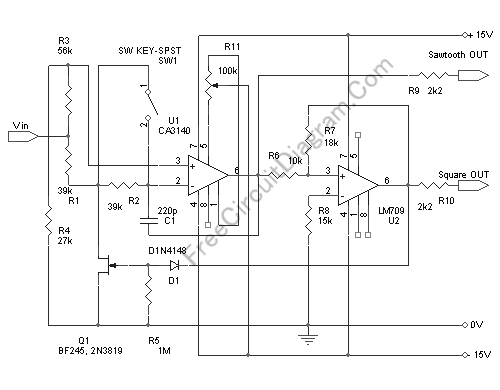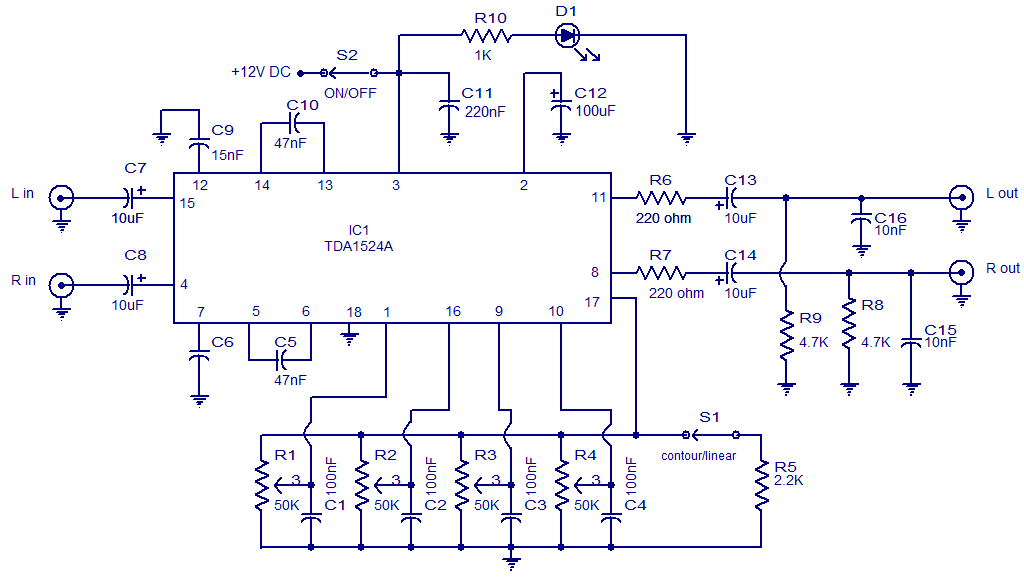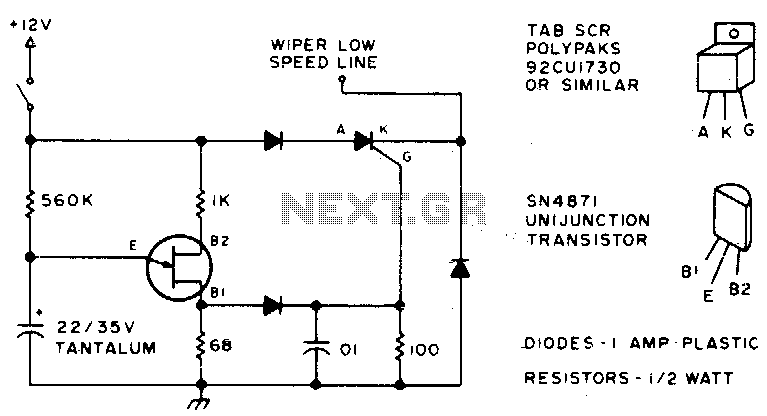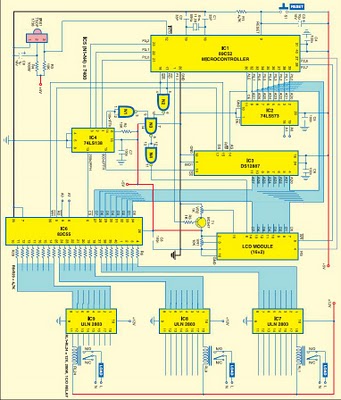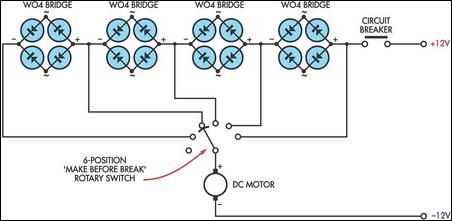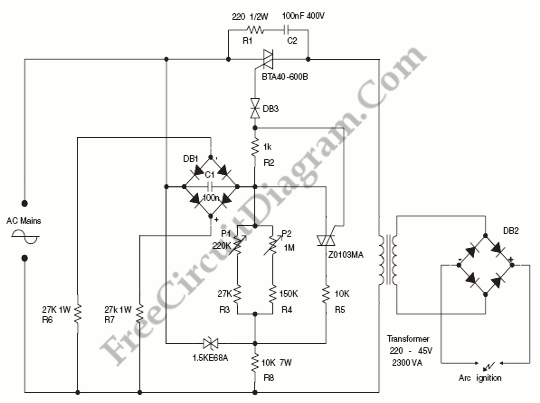
555 Duty Cycle Control
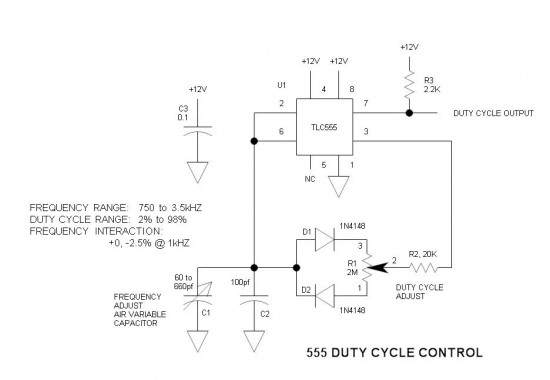
A simple oscillator circuit that varies the duty cycle over a wide range without affecting the frequency. It is a variation of the simple 555 astable oscillator. The use of an air-variable capacitor for frequency control is innovative. When potentiometer R1 is centered, the operation is straightforward and the duty cycle is 50%. However, as R1 is rotated in either direction, the charge time and discharge times vary accordingly. The two sides of R1 have independent steering diodes (D1 & D2). Capacitors C1 and C2 make up the timing capacitor. Pins 2 and 6 of the 555 are the upper and lower thresholds of the input comparators. The charge/discharge voltage is taken from pin 3 due to its rail-to-rail voltage swing, while the rectangular waveform output is taken from pin 7, where R3 serves as the pull-up resistor. If constant frequency is desired, C1 could be adjusted for the correct frequency; however, most experimenters also want variable frequency. R1 cannot vary in total resistance, limiting its ability to affect frequency. R2 could vary the frequency, but it would also affect the duty cycle ratio limits. The practical means of obtaining variable frequency lies in varying C1. The system includes a charge resistance and a discharge resistance, the sum of which is constant and equal to the total resistance of potentiometer R1 (1 to 3). Thus, the sum of the charge and discharge times remains constant, leading to a constant frequency. The air-variable capacitor, while outdated, is still useful and can be found on platforms like eBay. A recommended choice is a 3-gang 440pF capacitor, wired in parallel for a total capacitance of 1320pF. To achieve a reasonably low frequency, R1 is selected to have the highest possible resistance, with 2M being the maximum available. The TLC555 CMOS 555 is chosen for its high impedance capability and rail-to-rail output voltage, unlike the bipolar 555. The accuracy of the circuit may degrade if the slew rate at C1 exceeds approximately 0.25V/µs, resulting in significant propagation delay of the comparators and a drop in frequency. This limits the maximum frequency to below 50kHz for a 50% duty cycle or below 2kHz for a 98% duty cycle. To maintain 1% or 2% frequency accuracy, the duty cycle range must decrease as frequency increases.
This oscillator circuit utilizes the 555 timer IC in an astable configuration, which is renowned for its versatility in generating square wave signals. The key feature of this design is its ability to vary the duty cycle independently of the frequency, which is achieved through the innovative use of an air-variable capacitor. This capacitor allows for fine-tuning of the frequency while maintaining a constant total resistance in the timing network.
The circuit comprises two main resistors: R1, which is a potentiometer allowing for adjustable duty cycle, and R2, which plays a role in frequency determination. The independent steering diodes (D1 and D2) ensure that the charging and discharging paths of the timing capacitor (C1 and C2) are controlled effectively, allowing for precise timing adjustments.
The output waveform is taken from pin 7 of the 555 timer, which provides a rectangular signal. The pull-up resistor R3 is critical for ensuring that the output can swing to the supply rails, enhancing the circuit's overall performance.
For those seeking to maintain a consistent frequency while adjusting the duty cycle, careful selection of the components is essential. The TLC555 CMOS variant of the 555 timer is particularly advantageous due to its enhanced output characteristics and ability to operate at higher impedances.
The design considerations for this oscillator include the need to balance the values of R1 and C1 to achieve the desired frequency range, as well as the impact of component tolerances on the accuracy of the waveform. The use of an air-variable capacitor, while somewhat antiquated, provides a unique solution for those interested in experimental electronics and can yield rewarding results in terms of performance and versatility.
Overall, this oscillator circuit represents a practical and innovative approach to generating variable duty cycle waveforms while preserving frequency stability, making it a valuable addition to any electronics experimenter's toolkit.A simple oscillator circuit that varies the duty cycle over a wide range without affecting the frequency. It is a variation of the simple 555 astable oscillator. Initially, I told a reader that there was no standard 555 circuit that could do this, but then the grey matter started working.
The use of an air-variable capacitor for frequency control is a mind-blower ”nothing short of a time warp! When potentiometer R1 is centered, operation is obvious and the duty cycle is 50%. However, as R1 is rotated in either direction the charge time and discharge times vary accordingly. The two sides of R1 have independent steering diodes (D1 & D2). C1 & C2 make up the timing capacitor. Pins 2 & 6 of the 555 are the upper and lower thresholds of the input comparators. The charge /discharge voltage is taken from pin 3 because it has rail-to-rail voltage swing, and the open collector output (pin 7) cannot do this. The rectangular waveform output is taken from pin 7 instead. R3 is the pull-up resistor. If constant frequency is desired, C1 could be padded for the correct frequency. However, most experimenters also want variable frequency. Since R1 cannot be varied in total resistance, it cannot vary the frequency. R2 could vary the frequency, but would also affect the duty cycle ratio limits as well. The only practical means of obtaining variable frequency is to vary C1. So we have a charge resistance and a discharge resistance, the sum of which is constant and equal to the R1 potentiometer total resistance (1 to 3).
Therefore, the sum of the charge and discharge times is also constant. Since F = 1/T, the frequency is also be constant. The old-fashioned air variable capacitor is old and klunky. While DigiKey offers no such product, these devices remain available on eBay as used or old stock. Every serious experimenter should have one of these. The one I would buy is a 3-gang 440pf. Wired in parallel the total capacitance is 1320pf. Physical size limitations prevent higher capacitances. To obtain a reasonably low frequency, R1 had to be selected to have as high a resistance as possible. 2M is the highest value pot I had on hand. A 5M would also be a good selection. To function under such high impedance conditions, I selected the TLC555 CMOS 555. A further advantage of this device is that it has rail-to-rail output voltage ”something that the bipolar 555 cannot do.
The accuracy tends to degrade when the slew rate at C1 exceeds about 0. 25V/uS. When this happens, the propagation delay of the comparators becomes significant and the frequency drops somewhat. This causes the peaks of the saw-tooth waveform to skid past the thresholds before the output switches polarity.
This forces the maximum frequency to be lower than about 50kHZ for 50% duty cycle, or lower than 2kHZ with 98% duty cycle. To maintain 1 or 2% frequency accuracy the duty cycle range must drop as frequency increases. 🔗 External reference
This oscillator circuit utilizes the 555 timer IC in an astable configuration, which is renowned for its versatility in generating square wave signals. The key feature of this design is its ability to vary the duty cycle independently of the frequency, which is achieved through the innovative use of an air-variable capacitor. This capacitor allows for fine-tuning of the frequency while maintaining a constant total resistance in the timing network.
The circuit comprises two main resistors: R1, which is a potentiometer allowing for adjustable duty cycle, and R2, which plays a role in frequency determination. The independent steering diodes (D1 and D2) ensure that the charging and discharging paths of the timing capacitor (C1 and C2) are controlled effectively, allowing for precise timing adjustments.
The output waveform is taken from pin 7 of the 555 timer, which provides a rectangular signal. The pull-up resistor R3 is critical for ensuring that the output can swing to the supply rails, enhancing the circuit's overall performance.
For those seeking to maintain a consistent frequency while adjusting the duty cycle, careful selection of the components is essential. The TLC555 CMOS variant of the 555 timer is particularly advantageous due to its enhanced output characteristics and ability to operate at higher impedances.
The design considerations for this oscillator include the need to balance the values of R1 and C1 to achieve the desired frequency range, as well as the impact of component tolerances on the accuracy of the waveform. The use of an air-variable capacitor, while somewhat antiquated, provides a unique solution for those interested in experimental electronics and can yield rewarding results in terms of performance and versatility.
Overall, this oscillator circuit represents a practical and innovative approach to generating variable duty cycle waveforms while preserving frequency stability, making it a valuable addition to any electronics experimenter's toolkit.A simple oscillator circuit that varies the duty cycle over a wide range without affecting the frequency. It is a variation of the simple 555 astable oscillator. Initially, I told a reader that there was no standard 555 circuit that could do this, but then the grey matter started working.
The use of an air-variable capacitor for frequency control is a mind-blower ”nothing short of a time warp! When potentiometer R1 is centered, operation is obvious and the duty cycle is 50%. However, as R1 is rotated in either direction the charge time and discharge times vary accordingly. The two sides of R1 have independent steering diodes (D1 & D2). C1 & C2 make up the timing capacitor. Pins 2 & 6 of the 555 are the upper and lower thresholds of the input comparators. The charge /discharge voltage is taken from pin 3 because it has rail-to-rail voltage swing, and the open collector output (pin 7) cannot do this. The rectangular waveform output is taken from pin 7 instead. R3 is the pull-up resistor. If constant frequency is desired, C1 could be padded for the correct frequency. However, most experimenters also want variable frequency. Since R1 cannot be varied in total resistance, it cannot vary the frequency. R2 could vary the frequency, but would also affect the duty cycle ratio limits as well. The only practical means of obtaining variable frequency is to vary C1. So we have a charge resistance and a discharge resistance, the sum of which is constant and equal to the R1 potentiometer total resistance (1 to 3).
Therefore, the sum of the charge and discharge times is also constant. Since F = 1/T, the frequency is also be constant. The old-fashioned air variable capacitor is old and klunky. While DigiKey offers no such product, these devices remain available on eBay as used or old stock. Every serious experimenter should have one of these. The one I would buy is a 3-gang 440pf. Wired in parallel the total capacitance is 1320pf. Physical size limitations prevent higher capacitances. To obtain a reasonably low frequency, R1 had to be selected to have as high a resistance as possible. 2M is the highest value pot I had on hand. A 5M would also be a good selection. To function under such high impedance conditions, I selected the TLC555 CMOS 555. A further advantage of this device is that it has rail-to-rail output voltage ”something that the bipolar 555 cannot do.
The accuracy tends to degrade when the slew rate at C1 exceeds about 0. 25V/uS. When this happens, the propagation delay of the comparators becomes significant and the frequency drops somewhat. This causes the peaks of the saw-tooth waveform to skid past the thresholds before the output switches polarity.
This forces the maximum frequency to be lower than about 50kHZ for 50% duty cycle, or lower than 2kHZ with 98% duty cycle. To maintain 1 or 2% frequency accuracy the duty cycle range must drop as frequency increases. 🔗 External reference
